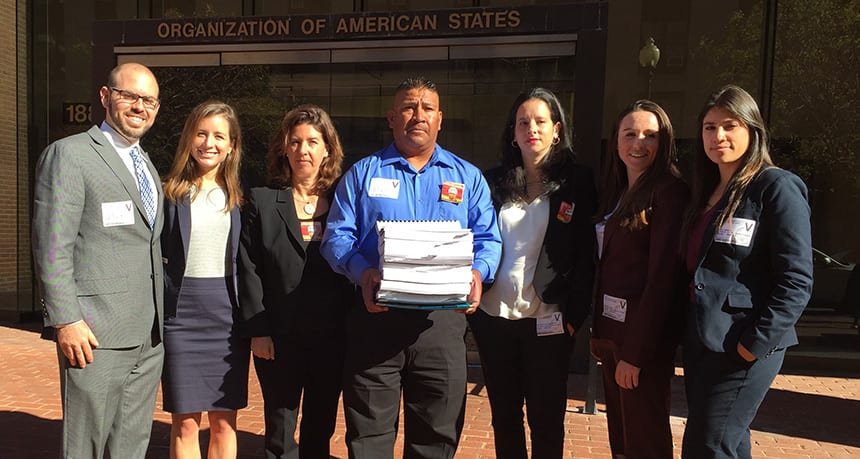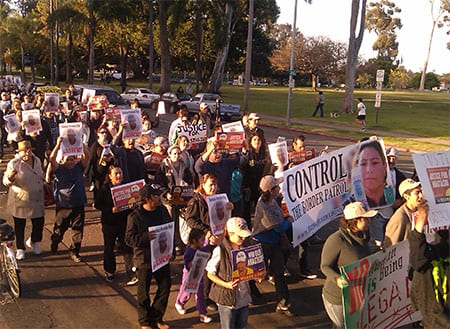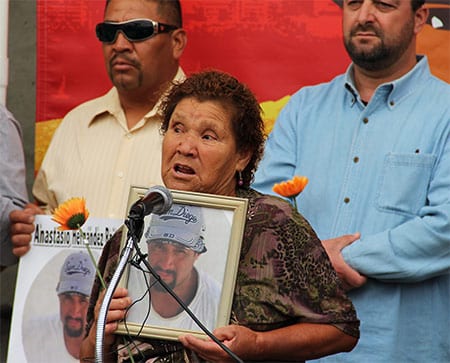
By Susan Gluss
A nearly six-year legal battle for justice took a new turn today (March 30) as the International Human Rights Law Clinic filed a petition against the United States for the death of a Mexican national by U.S. Customs and Border Protection (CBP). The complaint, filed with co-counsel Alliance San Diego before the Inter-American Commission on Human Rights, calls for an investigation into the killing and a condemnation of U.S. actions.
The deceased, Anastasio Hernandez Rojas, died on May 31, 2010, a few days after border agents took him into custody. The father of five was caught trying to cross the Mexican-U.S. border to rejoin his family in San Diego. He’d been deported just weeks earlier, despite having lived and worked in the U.S. for more than two decades.
CBP agents transported Anastasio to a deportation gate, and it’s there that the brutal beating ensued. As Anastasio objected to his detention, a dozen or more border agents punched, kicked, dragged, Tased, hogtied, and denied him medical attention, according to the petition.
Immobilized on the ground, Anastasio cried out for help in Spanish. His cries drew the attention of witnesses standing on a nearby pedestrian bridge, and several onlookers recorded cell phone footage. Border agents sought to confiscate any evidence—images, audio, video—but two eye-witnesses hid their phones and eventually released videos of the beating. Broadcast on U.S. news networks, the videos led to a public outcry and heightened scrutiny of the case.
An autopsy report revealed that Anastasio suffered bruises and abrasions on his face and body, five broken ribs, and hemorrhaging of internal organs. Anastasio died after suffering a heart attack, cardiac arrest, and brain damage. His death was ruled a homicide.
Despite the evidence and eyewitness accounts of the beating, federal prosecutors closed the criminal investigation last fall without pursuing criminal charges. The government was “unable to prove, beyond a reasonable doubt,” that the agents violated federal homicide statutes, according to a Dept. of Justice (DOJ) press release.
A fearless team
Enter Roxanna Altholz ’99, associate director of the International Human Rights Law Clinic, and a team of clinic students. They drafted the petition for the Inter-American Commission, a branch of the Organization of American States, claiming human rights abuses by the U.S.
It’s a tactic Altholz has employed before—as lead counsel on cases against Colombian drug lords and Guatemalan military officers—when victims found no redress in national courts.

“For decades, the Inter-American Commission has investigated exactly this kind of case—extrajudicial killings by law enforcement,” Altholz said. The commission “has developed clear standards on what circumstances justify the use of force by law enforcement, how on-duty killings should be investigated, and what the government should do to protect the rights of the victims’ family members.”
Students Amanda Barrow ’16, Jessica Oliva ’16, Kelsey Quigley ’17, and Aaron Voit ’17 hand-delivered the petition to the commission in Washington, D.C., along with Altholz, Anastasio’s brother, and Andrea Guerrero ’99, executive director of Alliance San Diego.
“Our collaboration with the clinic is a game changer,” Guerrero said. “With the clinic’s help, we can take this fight for justice to the international arena … against the U.S. government for its systemic failure to deliver justice to border victims.”
Oliva said it was time to hold the customs agency accountable for its “egregious violations of human rights.”
“As a child of parents who came to this country as undocumented migrants, this case hit particularly close to home,” Oliva wrote in an email. “I hope that by shedding light on this systemic issue, we take a step towards the day where the lives of all human beings are valued equally, irrespective of migratory status.”
Barrow said she was stunned by the “impunity” of agents who kill.
“I thought that this case—involving the brutal killing of an unarmed man while he was handcuffed, in law enforcement custody, and surrounded by dozens of witnesses—couldn’t possibly be dismissed, or swept under the rug. Devastatingly, that’s exactly what happened,” Barrow said.
Pattern of abuse
CBP is the nation’s largest law enforcement agency. Since 9/11, Congress has more than doubled its budget and increased its access to surveillance equipment, weaponry and technology. In the past six years alone, its agents have killed at least forty-six Mexican and U.S. nationals along the U.S.-Mexico border. Yet successful disciplinary, civil or criminal actions against agents are exceedingly rare. The DOJ has closed all but one criminal investigation of a killing without filing charges.
Anastasio’s family members are pursuing a civil case that has yet to go to trial in a California district court.

Law student Voit, a former community organizer in El Salvador, said this case has helped him understand the “dire threats facing undocumented immigrants.”
“U.S. law enforcement at the Southern border has a long history of violence and abuse directed towards undocumented immigrants,” Voit said. “The U.S. government has an obligation to respect, protect, and ensure the human rights of every human within our borders—undocumented or otherwise.”
For Quigley, working on this project added “an emotional, tragic, layer of complexity to a personal cultural awakening.” Although from San Diego, she hadn’t heard of the “struggle for justice” by Anastasio’s family. “I am now more aware of the pain, the gravity, and the ‘gray’ of living as an undocumented person in the U.S,” she said.
The issue of impunity by the border agency has to be seen in the context of policing nationwide, according to Guerrero. “If we are serious about holding law enforcement accountable for its actions from Ferguson, Missouri to San Diego, California, we must … hold CBP to the same standards that we seek to hold local police, without exception.”
International condemnation
If the commission pursues this case and finds the U.S. responsible for violating the human rights of Anastasio and his family, its recommendations could include: further investigation and punishment of the agents responsible; reparations for the damages caused; legislative reforms; apologies to the family members and other measures.
Altholz said it’s critical that an outside, international agency “without political interests” examine the case. “Given the problems with how U.S. authorities investigated this case, we need an independent panel of experts to review the use of force and the investigation to recommend reforms to CBP,” she said. “Security should not and cannot mean that it is ‘open season’ on border communities.”
By filing this complaint before the commission, added Barrow, we are “seeking to chip away at the militarization of the border and the violence committed by those who are charged with protecting us.”
For Anastasio’s brother, this latest legal maneuver offers a ray of light in an otherwise dark, difficult time.
“On behalf of my entire family, I am very grateful for the work of the clinic,” Bernardo Hernandez Rojas said. “With their help, we have new hope that one day we will get justice for Anastasio and that we will keep another family from suffering as we have.”